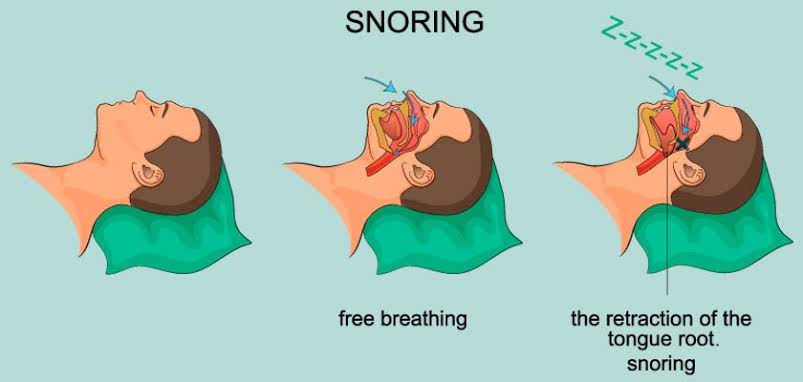In the dead of night, a mysterious force stirred, shattering the silence of the darkness. It was a sound so powerful, it could shake the foundations of a household. They called it “The Nocturnal Enigma” – a snore so fierce, it was as if the sleeper’s very soul was struggling to escape. Dr. Sophia, a renowned sleep specialist, was determined to unravel the secrets of this enigmatic phenomenon. She had seen the devastating effects it had on families, relationships, and even the snorers themselves.
As Sophia delved deeper into her research, she discovered a web of intrigue surrounding the nocturnal enigma. She encountered patients who had lost all hope, their lives ravaged by the constant disruptions. Yet, amidst the despair, Sophia found glimmers of hope. She stumbled upon an ancient text hinting at a long-forgotten remedy, hidden deep within the recesses of human knowledge. With each new discovery, Sophia’s determination grew. She was resolute in her pursuit of a solution, driven by the promise of a peaceful night’s sleep for all.
The day of reckoning finally arrived. Sophia stood at the threshold of her laboratory, ready to unveil her groundbreaking discovery. With a deep breath, she revealed the secret to taming the nocturnal enigma. The room erupted in a chorus of cheers and tears as the first patient, once a victim of the snore’s tyranny, slept peacefully through the night. Sophia’s triumph marked the beginning of a new era in sleep medicine, inspiring countless others to join the quest for a snore-free world. The nocturnal enigma was no more, replaced by the sweet serenade of peaceful slumber.
What is Snoring?

Snoring is the sound produced by the vibration of the soft tissues in the upper airway when a person breathes during sleep. It is a common phenomenon that affects millions of people worldwide.
Snoring occurs when the flow of air through the mouth and nose is partially blocked, causing the tissues in the throat to vibrate. These tissues include the:
1. Soft palate
2. Uvula
3. Tongue
4. Tonsils
5. Adenoids
The vibrations produce the characteristic snoring sound, which can range from a gentle hum to a loud, disruptive noise.
Causes
1. Obstructive Sleep Apnea (OSA)
2. Nasal congestion
3. Alcohol consumption
4. Being overweight or obese
5. Smoking
6. Sleep position (sleeping on your back)
7. Genetic predisposition
8. Hormonal changes
9. Certain medications
10. Large tonsils or adenoids
11. Long soft palate or uvula
12. Narrow airway
13. Allergies
14. Cold or sinus infection
15. Acid reflux
16. Pregnancy
17. Menopause
18. Sleep deprivation
19. Anatomical issues (e.g., deviated septum)
20. Relaxation of the throat muscles during sleep
Keep in mind that this list is not exhaustive, and snoring can have other causes as well. If you’re concerned about your snoring, it’s always a good idea to consult a healthcare professional to determine the underlying cause and appropriate treatment.
Here are some common signs and symptoms of snoring:
1. Loud, disruptive snoring sounds
2. Pauses in breathing (apnea) during sleep
3. Waking up with a dry mouth or sore throat
4. Morning headaches
5. Difficulty concentrating or feeling tired during the day
6. High blood pressure
7. Weight gain or obesity
8. Waking up frequently during the night
9. Gasping or choking sounds during sleep
10. Daytime sleepiness or fatigue
11. Difficulty staying asleep
12. Nasal congestion or difficulty breathing through the nose
13. Coughing or wheezing during sleep
14. Restless sleep or insomnia
15. Morning soreness in the throat or jaw
If you experience any of these signs and symptoms, it’s important to consult a healthcare professional to determine the underlying cause of your snoring and appropriate treatment.
Prevention
1. Sleep on your side: Avoid sleeping on your back, as this can cause your tongue and soft palate to relax and obstruct your airway.
2. Lose weight: If you are overweight or obese, losing weight can help reduce fat in the throat and improve airflow.
3. Exercise regularly: Regular exercise can help improve nasal breathing and reduce snoring.
4. Avoid alcohol and sedatives: Drinking alcohol and taking sedatives can relax your throat muscles, leading to snoring.
5. Quit smoking: Smoking can cause inflammation and irritation in the throat, leading to swelling and narrowing of the airway.
6. Use nasal strips or dilators: Nasal strips or dilators can help open up your nasal passages, improving airflow and reducing snoring.
7. Use an oral appliance: Custom-made oral appliances can help advance the position of your lower jaw and keep your airway open.
8. Try a humidifier: Dry air can irritate your throat and nasal passages, leading to swelling and congestion. Using a humidifier can help keep your airways moist and reduce snoring.
9. Avoid allergens: Allergens like dust, pollen, and pet dander can cause nasal congestion and swelling, leading to snoring.
10. Consider CPAP therapy: If you have sleep apnea, continuous positive airway pressure (CPAP) therapy can help keep your airway open and reduce snoring.
11. Try throat exercises: Certain exercises, like the “tongue lift” and “soft palate lift,” can help strengthen your throat muscles and improve airflow.
12. Consider a snoring mouthpiece: There are various mouthpieces available that can help advance the position of your lower jaw and keep your airway open.
Remember, if you’re a habitual snorer, it’s important to consult with a healthcare professional to rule out any underlying health issues.
Treatment
1. Lifestyle Changes:
– Weight loss
– Exercise
– Avoiding alcohol and sedatives
– Quitting smoking
– Sleeping on your side
2. Oral Appliance Therapy:
– Custom-made mouthpieces to advance the lower jaw and keep the airway open
3. Continuous Positive Airway Pressure (CPAP) Therapy:
– A machine that delivers constant air pressure to keep the airway open
4. Bi-Level Positive Airway Pressure (BiPAP) Therapy:
– A machine that delivers two different levels of air pressure to keep the airway open
5. Upper Airway Stimulation (UAS) Therapy:
– A device that stimulates the muscles in the upper airway to keep it open
6. Surgery:
– Uvulopalatopharyngoplasty (UPPP)
– Laser-Assisted Uvulopalatoplasty (LAUP)
– Somnoplasty
– Turbinate reduction
7. Radiofrequency Ablation (RFA):
– A minimally invasive procedure that uses heat to shrink the tissues in the throat
8. Nasal Expiratory Positive Airway Pressure (EPAP) Therapy:
– A device that delivers pressure to the nasal passages to keep the airway open
9. Snoring Mouthpieces:
– Over-the-counter devices that advance the lower jaw and keep the airway open
10. Home Remedies:
– Throat exercises
– Essential oils (e.g., peppermint, eucalyptus)
– Humidifiers
– Saline nasal sprays
It’s important to consult a healthcare professional to determine the best treatment for your specific case of snoring.

